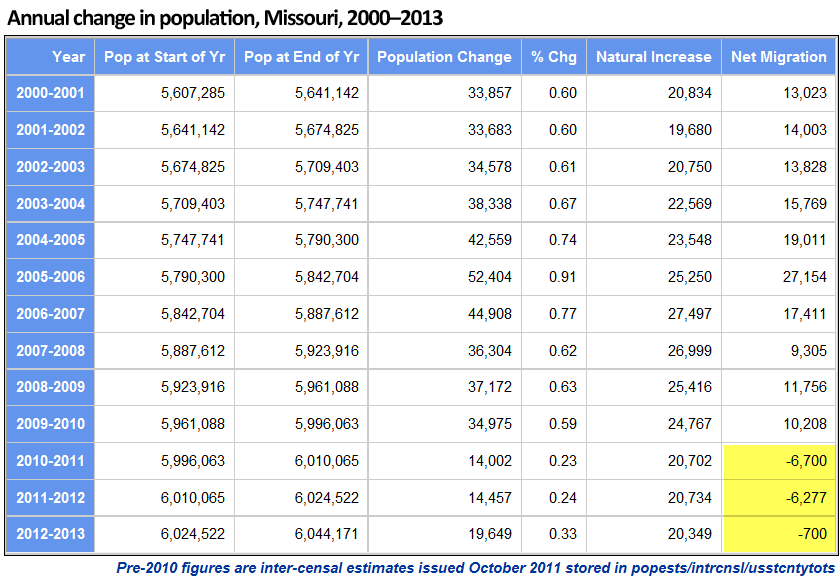This is the first in a series of three major substate estimate products to be released in the first half of 2014. Key items in this set include the 2013 estimated total population for each state, county, and metropolitan and micropolitan statistical areas (CBSAs). These products contain annual estimates (July 1, 2010 – July 1, 2013) and report components of change (births, deaths, migration) for each year since 2010 plus April–June, 2010. The five new datasets (mocom13, mocom13t, uscom13, uscomcbsas13, and mocomregns13) are available in the MCDC data warehouse. These datasets are all the same as last year but now include data through 2013 rather than 2012.
Missouri halts two-year rapid outmigration trend
The new estimates show that the state of Missouri added almost 20,000 new residents in the year July 1, 2012 – July 1, 2013. The data also show that the increase was due entirely to natural increase (births minus deaths), with net migration (persons moving into the state minus persons moving out) still showing a net loss (outmigration) of 700 persons.
While a loss of 700 people is no cause for celebration (for most people; there are those who think fewer people is a good thing) it breaks a two-year losing streak that was almost ten times worse. In the previous two years, the state lost an average of about 6,500 persons. In nine of the ten years prior to that, the state had a net in-migration of more than 10,000 (with a 9,305 increase in the worst of those years, 2007–2008).

Other interesting Missouri trends shown in the new estimates
- Boone County had its 13th consecutive year with at least 2,000 population added and more than 1,000 net in-migration. However, the total increase was down by more than 400 from the previous year and was the smallest increase since 2000–2001.
- The City of St. Louis had its worst year since since 2006–2007, when it lost more than 2,000 population. The loss this year (2012–2013) was only 696, but it came on the heels of two post-census years where the total loss had been only 145. Also, two years prior to that, St. Louis City had actually added about 1,300 people. These numbers (prior to 2010) are the intercensal adjustment figures, so they reflect a significant adjustment to the city’s population based on the results of the 2010 census, which showed that the city’s estimate challenges during the previous decade resulted in overestimates.
- The top 5 counties based on population added over the last 3¼ years (4/1/2010 – 7/1/2013) were St. Charles (13,010), Greene (8,696), Clay (8,534), Boone (8,131), and Jackson (5,838). Boone had the largest percentage increase (5.0%), with Christian County second (4.5%). The top five ranked by change in the most recent year were the same, although Jackson and Boone switched ranks.
- The five biggest losers of population since the 2010 census were Jasper (-1,006), St. Louis City (-940), Stone (-905), New Madrid (-595), and McDonald (-525). Note that three of these five counties are located in the far southwest corner of the state.
- Counties within Metropolitan Statistical Areas in the state have shown a growth of 59,385 (1.3%) since the 2010 census, whereas those within Micropolitan SAs added only 4,375 people (0.6%). The 59 counties in the state that are outside any metro- or micropolitan area had a net loss of 8,512 people (-1.0%).
- We created the mocomregns13 data set to summarize these trends by various county-based regions in Missouri. One of the region types included is Regional Planning Commissions (RPCs). The five RPCs with the greatest population gain since the 2010 census were Mid-America (Kansas City area, 19,068), East-West Gateway (St. Louis area, 17,615), Southwest Missouri COG (Springfield area, 12,248), Mid-Missouri (Columbia area, 9,170) and SEMO RPC (Cape Girardeau area, 2,277). The three RPCs with the greatest population loss were Green Hills, Kaysinger Basin and Bootheel.
- Missouri ranks 18th in total population in 2013 (same rank as in 2010) and 26th in population change since the 2010 census (40th in percent change over that period). The state ranks 47th in net migration since the last census. That puts us just behind 46th-ranked New York (but they have a much larger population, and much of their out-migration is for retirement), and ahead of the nation’s four biggest losers: Mississippi (48), Ohio (49), Michigan (50) and Illinois (51).
In case anyone is interested, we got all these numbers by accessing the new uscom13 data set in the popests data directory using Uexplore/Dexter, filtering to get just state level summaries (sumlev = 040), keeping the relevant variables, and passing it all to Rankster to do the rankings for us.

